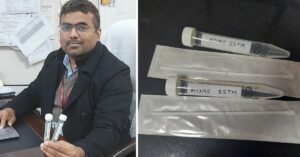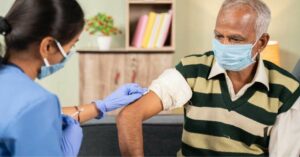Day 6 of The Covid-19 Infection: Pulmonologist Clears Myths About The ‘Second Week’
Dr Vikas Maurya, Director and Head of Department, Pulmonology, Fortis Hospital Shalimar Bagh answers questions about co-morbidities and COVID-19.

This article is a part of a series by The Better India to share verified information about COVID-19 care. While several posts on various aspects of fighting COVID-19 are being circulated on social media and messaging services like WhatsApp, we urge you not to trust unverified content. To separate fact from fiction, we will be sharing the videos and content with doctors and experts and bring you their responses with scientific research-backed information.
The latest set of WhatsApp messages doing the rounds is all about being conscious of the sixth day in the life-cycle of a COVID-19 positive patient. Doctors believe that one must keep a close watch on the vitals from the sixth day onwards since the chances of deterioration are higher.

Dr Vikas Maurya, Director and Head of Department, Pulmonology, Fortis Hospital Shalimar Bagh, answers questions to help us understand this better.
Q1. Is it true that for the first five days, one may not have any symptom?
Dr Maurya: No, not true. You may or may not have symptoms. It all depends on the viral load, and there is no hard and fast rule to understanding this. It is important to stay vigilant right through the 14 days that one stays in isolation. The day you notice your first symptoms should be counted as day 1, and you need to immediately reach out to your physician.
Q2. The doctor in the video suggests that only from day 6 onwards the real effect of COVID-19 is seen? Is that true?
Dr Maurya: No, not true. The symptoms that one experiences in COVID-19 can begin with simple symptoms like throat irritation and cough. A fever may or may not accompany these symptoms.
Q3. If the fever reaches 101 or 102 – does it mean that the virus has travelled to the lungs?
Dr Maurya: Yes, when you have a persistent high-grade fever, it means lungs are getting involved. At this stage, it is imperative to reach out to your physician to get your medicines checked, and dosage increased or changed if the need arises.
Q 4. If we start treatment right at the beginning, then the chances of having to get on oxygen or have intensive treatment reduce – is that accurate?
Dr Maurya: Yes, this is true. If one were to start treatment early on, then the severity of the disease and complications that arise due to it can be decreased. It is, therefore, important that you contact your physician immediately when the first symptom shows up.
Q 5. At what oxygen saturation level should one start looking for oxygen beds and hospital admission?
Dr Maurya: Saturation less than 94 means lungs are involved. At this point, speaking to your physician and following the treatment protocol suggested is important.
To help get the oxygen saturation levels up, one could also try the prone technique at home. Click here to find out the right technique to follow.
Q 6. How important is the 6th day in COVID-19 management??
Dr Maurya: It is important as it marks your entry into the second week of managing the disease. It is also indicative of the time when the virus travels to the lungs and causes cytokine storms.
Q7. How dangerous is it for someone who has diabetes to get COVID-19?
Dr Maurya: COVID-19 affects those who already have co-morbidities, and those with diabetes are at the highest risk. The steroids prescribed as part of the treatment course can also lead to a spike in sugar levels. If you are consulting a physician who is unaware of your medical history, please make sure you discuss it during your first consult.
Q 8. If I am diabetic and test positive for COVID – should I stop starch and sugar from my diet when I am being treated?
Dr Maurya: Ideally, you should have stopped it earlier on itself. The sugar should be in control early on, and managing it once you test positive for COVID-19 might not be the answer.
Q9. In the video, the doctor seems to suggest that the only course of treatment for COVID-19 is steroid and oxygen – is that accurate? What about plasma and Remdesivir?
Dr Maurya: Remdesivir is an antiviral drug that is used in the early part of the disease. Plasma therapy also is used during the early onset of COVID-19. Steroids and oxygen are usually used at a later stage of the disease when it has progressed to moderate or severe.
Do not self-medicate and follow the advice given online. You must consult a physician and get medicines specific to your needs.
(Edited by Vinayak Hegde)
This story made me
- 97
- 121
- 89
- 167
Tell Us More
We bring stories straight from the heart of India, to inspire millions and create a wave of impact. Our positive movement is growing bigger everyday, and we would love for you to join it.
Please contribute whatever you can, every little penny helps our team in bringing you more stories that support dreams and spread hope.



















